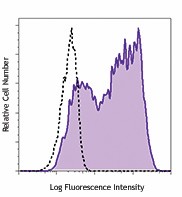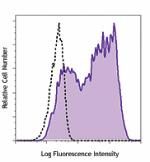- Clone
- 14E3G7 (See other available formats)
- Regulatory Status
- RUO
- Other Names
- For CD209: CDSIGN, CLEC4L, DC-SIGN, DC-SIGN1, For CD299: LSIGN, CD209L, L-SIGN, DCSIGNR, HP10347, DC-SIGN2, DC-SIGNR
- Isotype
- Mouse IgG2b, κ
- Ave. Rating
- Submit a Review
- Product Citations
- publications

-

Human monocyte-derived dendritic cells were stained with purified CD209/CD299 (DC-SIGN/L-SIGN) (clone 14E3G7) (filled histogram) or purified mouse IgG2b, κ isotype control (open histogram), and then was followed by anti-mouse IgG PE.
| Cat # | Size | Price | Quantity Check Availability | Save | ||
|---|---|---|---|---|---|---|
| 845002 | 100 µg | 212€ | ||||
DC-SIGN is a C-type lectin that has a high affinity for the ICAM3 molecule. It binds various microorganisms by recognizing high-mannose-containing glycoproteins on their envelopes. It especially functions as a receptor for several viruses such as HIV and Hepatitis C. L-SIGN is a transmembrane receptor and is referred to as L-SIGN because of its expression in the endothelial cells of the lymph nodes and liver. The protein is involved in the innate immune system and recognizes numerous evolutionarily divergent pathogens ranging from parasites to viruses. The protein is organized into three distinct domains: an N-terminal transmembrane domain, a tandem-repeat neck domain, and a C-type lectin carbohydrate recognition domain.
Product DetailsProduct Details
- Verified Reactivity
- Human
- Antibody Type
- Monoclonal
- Host Species
- Mouse
- Immunogen
- DC-SIGN DNA.
- Formulation
- Phosphate-buffered solution, pH 7.2, containing 0.09% sodium azide.
- Preparation
- The antibody was purified by affinity chromatography.
- Concentration
- 0.5 mg/ml
- Storage & Handling
- The antibody solution should be stored undiluted between 2°C and 8°C.
- Application
-
FC - Quality tested
- Recommended Usage
-
Each lot of this antibody is quality control tested by immunofluorescent staining with flow cytometric analysis. For flow cytometric staining, the suggested use of this reagent is ≤0.5 µg per million cells in 100 µl volume. It is recommended that the reagent be titrated for optimal performance for each application.
- Application Notes
-
Clone 14E3G7 has been shown to recognize both CD209 and CD299 transfectants.1
- Application References
-
- Granelli-Piperno A, et al. 2005. J. Immunol. 175:4265.
- Product Citations
-
- RRID
-
AB_2566004 (BioLegend Cat. No. 845002)
Antigen Details
- Structure
- DC-SIGN is a 44 kD type II transmembrane glycoprotein and a member of the C-type lectin family. DC-SIGNR (DC-SIGN-related molecule) is a type II integral membrane protein that is 77% identical to DC-SIGN.
- Distribution
-
CD209 is expressed on myeloid dendritic cells, placental macrophages, and liver and placental endothelial cells. CD299 is expressed on liver sinusoidal endothelial cells, lung and placental endothelial cells, type 2 alveolar cells, and endothelial cells of lymph nodes.
- Function
- CD299 mediates interactions between dendritic cells and resting T cells and has a high affinity for HIV-1 gp120. CD209 plays a critical role in capturing and internalizing pathogens. LSP1 (leukocyte-specific protein 1) interacts with the cytoplasmic domain of CD209 and mediates the transport of HIV to the proteasome.
- Interaction
- CD209 is a receptor of viruses such as HIV-1, West Nile Virus, hepatitis C virus, some bacteria, and parasites. CD299 binds carbohydrate structures of pathogens such as hepatitis C virus, Mycobacterium, etc.
- Ligand/Receptor
- CD209 binds to ICAM-3 (CD50), ICAM-2 (CD102), and Butyrophilin (BTNA2A1). CD299 is a receptor for ICAM-3 (CD50).
- Cell Type
- Dendritic cells, Endothelial cells, Macrophages
- Biology Area
- Cell Biology, Immunology, Innate Immunity, Neuroinflammation, Neuroscience
- Molecular Family
- CD Molecules
- Antigen References
-
1. Fauci A. 1996. Nature 384:529.
2. Yokoyama-Kobayashi M, et al. 1999. Gene 228:161.
3. Soilleux EJ, et al. 2000. J. Immunol. 165:2937.
4. Pohlmann S, et al. 2001. Proc. Natl. Acad. Sci. USA 98:2670.
5. Bashirova AA, et al. 2001. J. Exp. Med. 193:671.
6. Lai WK, et al. 2006. Am. J. Pathol. 169:200. - Gene ID
- 30835 View all products for this Gene ID 10332 View all products for this Gene ID
- UniProt
- View information about CD209 on UniProt.org
Related FAQs
Other Formats
View All CD209 Reagents Request Custom Conjugation| Description | Clone | Applications |
|---|---|---|
| Purified anti-CD209/CD299 (DC-SIGN/L-SIGN) | 14E3G7 | FC |
| TotalSeq™-C1138 anti-CD209/CD299 (DC-SIGN/L-SIGN) Antibody | 14E3G7 | PG |
Compare Data Across All Formats
This data display is provided for general comparisons between formats.
Your actual data may vary due to variations in samples, target cells, instruments and their settings, staining conditions, and other factors.
If you need assistance with selecting the best format contact our expert technical support team.
-
Purified anti-CD209/CD299 (DC-SIGN/L-SIGN)

Human monocyte-derived dendritic cells were stained with pur... -
TotalSeq™-C1138 anti-CD209/CD299 (DC-SIGN/L-SIGN) Antibody
 Login / Register
Login / Register 







Follow Us